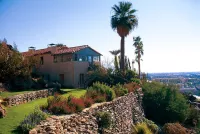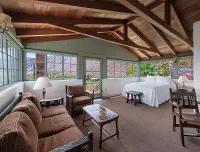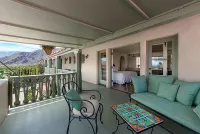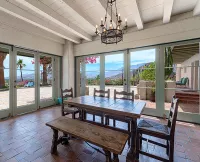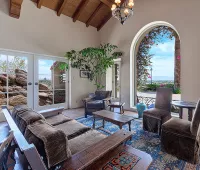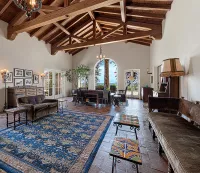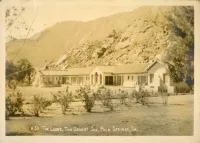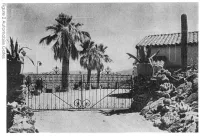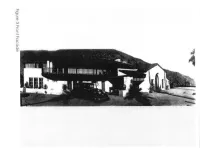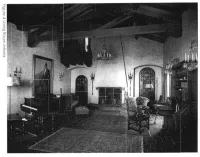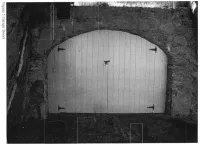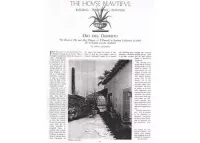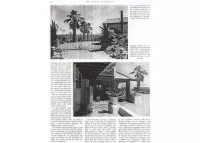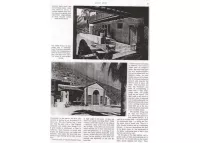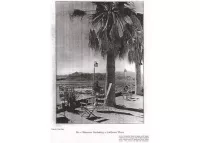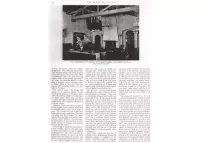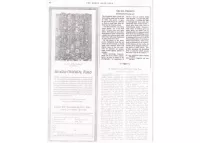Share what you know,
and discover more.
Share what you know,
and discover more.
Jun 01, 2019
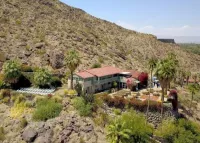
-

- Dave D
The O'Donnell House at the WIllows
Ojo del Desierto, Eye of the Desert, was completed by January of 1925 as the winter home of oilman Thomas O’Donnell and his wife, Dr. Winnifred Willis Jenny, a well-known Long Beach osteopath. Now known as the O’Donnell House, Ojo del Desierto was designed by architect and artist William Charles Tanner and built by Alvah Hicks as supervised by Nellie Coffman, owner of the Desert Inn. The Mediterranean Revival-Monterey two-story residence remained the highest mountainside home in Palm Springs until the 1960s. The O’Donnell House was built with four bedrooms and six fireplaces. The 4,200 square-foot home was constructed on 15 acres of land leased from the Desert Inn for 25 years with a subsequent 25-year renewal. This unusual arrangement was the first Palm Springs land-lease, behind which lies an interesting tale. At the Desert Inn, a Home for the O’Donnells Multimillionaire Tom O’Donnell had come to Palm Springs in the early 1920s seeking relief from a respiratory condition. He stayed at “Mother” Nellie Coffman’s frame-sided boarding house where he enjoyed her well-known hospitality. A friendship and feelings of mutual trust and respect ripened into an advantageous business arrangement. Nellie’s wish to rebuild and expand in the then popular “California Spanish” style and Tom’s desire for a separate permanent home, one that possessed all the advantages of Mother Coffman’s hospitality, resulted in a deal. W.C. Tanner would serve as their joint architect, Nellie as the building contractor and straw boss, and Tom as the financial underwriter. While Tom and Winnifred wed and honeymooned at the Willard Hotel in Washington, D.C., construction on both the Inn and the “Eye” began. Nellie would not sell the land to Tom for his “Eye on the Desert,” but she would agree to lease him the land for a total of fifty years, after which the property would revert to the Desert Inn. Access to the property was confirmed by an easement across Desert Inn grounds. In order to oversee and complete construction for the 1925 winter season, Nellie, who was then almost sixty, made two round-trip hikes daily up and down the treacherous trail. Upon their return, the O’Donnells were delighted with their magnificent residence, which in 1928 was the subject of a feature article in House Beautiful magazine. The house was intended to be private for the family. The kitchen was small and major meals were taken at the Inn. Evening entertainments were plentiful and dinner was generally followed by bridge with guests or friends from the village. No swimming pool was built outside the house, as the Desert Inn’s pool lay at the base of the “Eye of the Desert.” Both O’Donnells preferred playing golf to most any other amusement. The front yard of the house was actually the course through which the driveway ran before reaching the ascent to the house itself, which had a far-flung address to the north of the course off Alejo. The O’Donnell’s wintered at the “Eye” for fifteen years until Tom’s heart condition precluded his use of the stairs. It was decided then to build a smaller one-story home on the golf course so that he might continue to be a part of the game by looking on as others played. It was in that residence, now the Club House, that Tom suffered a heart attack at the age of seventy-five. He died in a Los Angeles hospital and is buried at Forest Lawn cemetery in Glendale. The promontory rock wall to the north of the O’Donnell House was to be his burial site and had been constructed as a make-work project during the Depression to give locals a job. Tom had paid $2.50 a day for anyone in need to stack stone in order to construct its massive walls. Inside these walls is a crypt in which he had intended to be buried. California law, however, forbids burial on private land. After the O’Donnells Subsequently, the O’Donnell House would become the winter residence of Nathan and Virginia Milnor. After Mrs. Milnor’s Death, the house became the possession of Home Savings, purchased by W.H. Ahamanson along with the Desert Inn, and in 1978 it was acquired by the Desert Museum. For several years, the house was used by the Artist’s Council, known as Hilltop Studio. Workshops, exhibits, demonstrations and receptions were held there. Since 1993 it has been in private ownership. In 2000 it was acquired by the present owners who began its restoration to its original glory. The City of Palm Springs recognized it as a Historic Site in 1986 and in 2000, and in 2010 it was nominated to the National Register of Historic Places and the State Office of Historic Preservation adopted the resolution recommending it be listed. In 2011 it was included on the list.
The O'Donnell House at the WIllows
Ojo del Desierto, Eye of the Desert, was completed by January of 1925 as the winter home of oilman Thomas O’Donnell and his wife, Dr. Winnifred Willis Jenny, a well-known Long Beach osteopath. Now known as the O’Donnell House, Ojo del Desierto was designed by architect and artist William Charles Tanner and built by Alvah Hicks as supervised by Nellie Coffman, owner of the Desert Inn. The Mediterranean Revival-Monterey two-story residence remained the highest mountainside home in Palm Springs until the 1960s. The O’Donnell House was built with four bedrooms and six fireplaces. The 4,200 square-foot home was constructed on 15 acres of land leased from the Desert Inn for 25 years with a subsequent 25-year renewal. This unusual arrangement was the first Palm Springs land-lease, behind which lies an interesting tale. At the Desert Inn, a Home for the O’Donnells Multimillionaire Tom O’Donnell had come to Palm Springs in the early 1920s seeking relief from a respiratory condition. He stayed at “Mother” Nellie Coffman’s frame-sided boarding house where he enjoyed her well-known hospitality. A friendship and feelings of mutual trust and respect ripened into an advantageous business arrangement. Nellie’s wish to rebuild and expand in the then popular “California Spanish” style and Tom’s desire for a separate permanent home, one that possessed all the advantages of Mother Coffman’s hospitality, resulted in a deal. W.C. Tanner would serve as their joint architect, Nellie as the building contractor and straw boss, and Tom as the financial underwriter. While Tom and Winnifred wed and honeymooned at the Willard Hotel in Washington, D.C., construction on both the Inn and the “Eye” began. Nellie would not sell the land to Tom for his “Eye on the Desert,” but she would agree to lease him the land for a total of fifty years, after which the property would revert to the Desert Inn. Access to the property was confirmed by an easement across Desert Inn grounds. In order to oversee and complete construction for the 1925 winter season, Nellie, who was then almost sixty, made two round-trip hikes daily up and down the treacherous trail. Upon their return, the O’Donnells were delighted with their magnificent residence, which in 1928 was the subject of a feature article in House Beautiful magazine. The house was intended to be private for the family. The kitchen was small and major meals were taken at the Inn. Evening entertainments were plentiful and dinner was generally followed by bridge with guests or friends from the village. No swimming pool was built outside the house, as the Desert Inn’s pool lay at the base of the “Eye of the Desert.” Both O’Donnells preferred playing golf to most any other amusement. The front yard of the house was actually the course through which the driveway ran before reaching the ascent to the house itself, which had a far-flung address to the north of the course off Alejo. The O’Donnell’s wintered at the “Eye” for fifteen years until Tom’s heart condition precluded his use of the stairs. It was decided then to build a smaller one-story home on the golf course so that he might continue to be a part of the game by looking on as others played. It was in that residence, now the Club House, that Tom suffered a heart attack at the age of seventy-five. He died in a Los Angeles hospital and is buried at Forest Lawn cemetery in Glendale. The promontory rock wall to the north of the O’Donnell House was to be his burial site and had been constructed as a make-work project during the Depression to give locals a job. Tom had paid $2.50 a day for anyone in need to stack stone in order to construct its massive walls. Inside these walls is a crypt in which he had intended to be buried. California law, however, forbids burial on private land. After the O’Donnells Subsequently, the O’Donnell House would become the winter residence of Nathan and Virginia Milnor. After Mrs. Milnor’s Death, the house became the possession of Home Savings, purchased by W.H. Ahamanson along with the Desert Inn, and in 1978 it was acquired by the Desert Museum. For several years, the house was used by the Artist’s Council, known as Hilltop Studio. Workshops, exhibits, demonstrations and receptions were held there. Since 1993 it has been in private ownership. In 2000 it was acquired by the present owners who began its restoration to its original glory. The City of Palm Springs recognized it as a Historic Site in 1986 and in 2000, and in 2010 it was nominated to the National Register of Historic Places and the State Office of Historic Preservation adopted the resolution recommending it be listed. In 2011 it was included on the list.
Jun 01, 2019
The O'Donnell House at the WIllows
Ojo del Desierto, Eye of the Desert, was completed by January of 1925 as the winter home of oilman Thomas O’Donnell and his wife, Dr. Winnifred Willis Jenny, a well-known Long Beach osteopath.Now known as the O’Donnell House, Ojo del Desierto was designed by architect and artist William Charles Tanner and built by Alvah Hicks as supervised by Nellie Coffman, owner of the Desert Inn. The Mediterranean Revival-Monterey two-story residence remained the highest mountainside home in Palm Springs until the 1960s. The O’Donnell House was built with four bedrooms and six fireplaces.
The 4,200 square-foot home was constructed on 15 acres of land leased from the Desert Inn for 25 years with a subsequent 25-year renewal. This unusual arrangement was the first Palm Springs land-lease, behind which lies an interesting tale.
At the Desert Inn, a Home for the O’Donnells
Multimillionaire Tom O’Donnell had come to Palm Springs in the early 1920s seeking relief from a respiratory condition. He stayed at “Mother” Nellie Coffman’s frame-sided boarding house where he enjoyed her well-known hospitality. A friendship and feelings of mutual trust and respect ripened into an advantageous business arrangement. Nellie’s wish to rebuild and expand in the then popular “California Spanish” style and Tom’s desire for a separate permanent home, one that possessed all the advantages of Mother Coffman’s hospitality, resulted in a deal. W.C. Tanner would serve as their joint architect, Nellie as the building contractor and straw boss, and Tom as the financial underwriter. While Tom and Winnifred wed and honeymooned at the Willard Hotel in Washington, D.C., construction on both the Inn and the “Eye” began.
Nellie would not sell the land to Tom for his “Eye on the Desert,” but she would agree to lease him the land for a total of fifty years, after which the property would revert to the Desert Inn. Access to the property was confirmed by an easement across Desert Inn grounds. In order to oversee and complete construction for the 1925 winter season, Nellie, who was then almost sixty, made two round-trip hikes daily up and down the treacherous trail. Upon their return, the O’Donnells were delighted with their magnificent residence, which in 1928 was the subject of a feature article in House Beautiful magazine.
The house was intended to be private for the family. The kitchen was small and major meals were taken at the Inn. Evening entertainments were plentiful and dinner was generally followed by bridge with guests or friends from the village. No swimming pool was built outside the house, as the Desert Inn’s pool lay at the base of the “Eye of the Desert.” Both O’Donnells preferred playing golf to most any other amusement. The front yard of the house was actually the course through which the driveway ran before reaching the ascent to the house itself, which had a far-flung address to the north of the course off Alejo.
The O’Donnell’s wintered at the “Eye” for fifteen years until Tom’s heart condition precluded his use of the stairs. It was decided then to build a smaller one-story home on the golf course so that he might continue to be a part of the game by looking on as others played. It was in that residence, now the Club House, that Tom suffered a heart attack at the age of seventy-five. He died in a Los Angeles hospital and is buried at Forest Lawn cemetery in Glendale. The promontory rock wall to the north of the O’Donnell House was to be his burial site and had been constructed as a make-work project during the Depression to give locals a job. Tom had paid $2.50 a day for anyone in need to stack stone in order to construct its massive walls. Inside these walls is a crypt in which he had intended to be buried. California law, however, forbids burial on private land.
After the O’Donnells
Subsequently, the O’Donnell House would become the winter residence of Nathan and Virginia Milnor. After Mrs. Milnor’s Death, the house became the possession of Home Savings, purchased by W.H. Ahamanson along with the Desert Inn, and in 1978 it was acquired by the Desert Museum. For several years, the house was used by the Artist’s Council, known as Hilltop Studio. Workshops, exhibits, demonstrations and receptions were held there. Since 1993 it has been in private ownership.
In 2000 it was acquired by the present owners who began its restoration to its original glory. The City of Palm Springs recognized it as a Historic Site in 1986 and in 2000, and in 2010 it was nominated to the National Register of Historic Places and the State Office of Historic Preservation adopted the resolution recommending it be listed. In 2011 it was included on the list.
Posted Date
Dec 30, 2021
Historical Record Date
Jun 01, 2019
Source Name
The O'Donnell House at the WIllows
Source Website
Delete Story
Are you sure you want to delete this story?
Jan 07, 2011
Jan 07, 2011
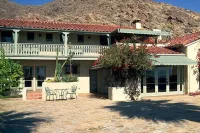
-

- Dave D
Charles Tanner - The Architect
The designer of the O’Donnell Residence, William Charles Tanner (1876-1960), was the son of English immigrants who arrived in Canada in 1875. The family soon immigrated to the United States, ultimately settling in Elgin, Illinois. By the age of seventeen. Tanner found work as an illustrator for Christian children’s book publisher David C. Cook Publications. By 1890 Tanner had moved to Chicago where he met and married Charlotte Mae "Lottie” Whitney, with whom he had two daughters. Tanner studied art in Chicago (1903-1908), Boston (1908-09), New York (1909-11), and Paris and Giverny, France (1911-14). At the age of 38, Tanner relocated his family to Riverside, California. He is mentioned briefly in Esther Klotz’ definitive The Mission Inn: Its History and Artifacts, as having loaned paintings to the hotel which were hung with their collection of Mexican and Spanish paintings. To supplement his income as an artist and art teacher, in 1921 Tanner opened an architectural practice located in Riverside at 624 Main Street. Although the California Architectural Registration Board has confirmed that Tanner was never licensed in the State; he is credited with having designed houses in Riverside, as well as workers’ cottages for the Southern Sierra Power Company. In 1924, the Tanners moved to Hollywood where he worked as a draftsman in the office of architect G. Vincent Palmer (1902-1992). The 22-year-old Palmer - who was born in Fabian, Indiana and died in San Bernardino at age 90 - had just completed his Bachelor of Science in Architecture at the University of Southern California and immediately established his practice, employing the 42-year-old Tanner as a draftsman, a position Tanner held for thirty-five years.^ An obituary in the Los Angeles Times confirms the death of “architectural artist and draftsman” Charles Tanner at the advanced age of 83, in Santa Monica on October 13, 1960. He was survived by Lottie and their daughters. Although Tanner is credited with the design of several more Spanish Colonial Revival-style houses, it is unknown how Tanner managed to transform his education as an American Impressionist painter into the skills required to work as a building designer without formal education or work experience as an architect. In Palm Springs, Tanner is credited with the design of the Carrie Birge Residence - now the Ingleside Inn (1922), George Roberson House - now Le Vallauris Restaurant (1924), the O’Donnell House (1925), and the huge, sprawling reconstruction of The Desert Inn (1922-27). All tour of these projects were designed and built in the Spanish Colonial Revival style, which between the years 1920 and 1930, was the dominant style of California architecture. The three extant buildings are locally designated Class 1 Historic Sites. In 1936, he designed his only non-Spanish Colonial Revival Palm Springs project, the First Community Church an early modernist design created through a novel use of the decorative concrete block. Like Tanner’s other Palm Springs projects, this is a Class 1 Historic Site. Lottie Tanner was the Assistant Chair of the extant Palm Springs Women’s Club in the 1930s during the time that Mrs. O’Donnell was Chair. Nellie Coffman was the head of the Building Committee. Palm Springs City Directories indicate the Tanners maintained a Palm Springs residence in the Los Hacienditas Tract (Movie Colony) in the years 1935-37.
Charles Tanner - The Architect
The designer of the O’Donnell Residence, William Charles Tanner (1876-1960), was the son of English immigrants who arrived in Canada in 1875. The family soon immigrated to the United States, ultimately settling in Elgin, Illinois. By the age of seventeen. Tanner found work as an illustrator for Christian children’s book publisher David C. Cook Publications. By 1890 Tanner had moved to Chicago where he met and married Charlotte Mae "Lottie” Whitney, with whom he had two daughters. Tanner studied art in Chicago (1903-1908), Boston (1908-09), New York (1909-11), and Paris and Giverny, France (1911-14). At the age of 38, Tanner relocated his family to Riverside, California. He is mentioned briefly in Esther Klotz’ definitive The Mission Inn: Its History and Artifacts, as having loaned paintings to the hotel which were hung with their collection of Mexican and Spanish paintings. To supplement his income as an artist and art teacher, in 1921 Tanner opened an architectural practice located in Riverside at 624 Main Street. Although the California Architectural Registration Board has confirmed that Tanner was never licensed in the State; he is credited with having designed houses in Riverside, as well as workers’ cottages for the Southern Sierra Power Company. In 1924, the Tanners moved to Hollywood where he worked as a draftsman in the office of architect G. Vincent Palmer (1902-1992). The 22-year-old Palmer - who was born in Fabian, Indiana and died in San Bernardino at age 90 - had just completed his Bachelor of Science in Architecture at the University of Southern California and immediately established his practice, employing the 42-year-old Tanner as a draftsman, a position Tanner held for thirty-five years.^ An obituary in the Los Angeles Times confirms the death of “architectural artist and draftsman” Charles Tanner at the advanced age of 83, in Santa Monica on October 13, 1960. He was survived by Lottie and their daughters. Although Tanner is credited with the design of several more Spanish Colonial Revival-style houses, it is unknown how Tanner managed to transform his education as an American Impressionist painter into the skills required to work as a building designer without formal education or work experience as an architect. In Palm Springs, Tanner is credited with the design of the Carrie Birge Residence - now the Ingleside Inn (1922), George Roberson House - now Le Vallauris Restaurant (1924), the O’Donnell House (1925), and the huge, sprawling reconstruction of The Desert Inn (1922-27). All tour of these projects were designed and built in the Spanish Colonial Revival style, which between the years 1920 and 1930, was the dominant style of California architecture. The three extant buildings are locally designated Class 1 Historic Sites. In 1936, he designed his only non-Spanish Colonial Revival Palm Springs project, the First Community Church an early modernist design created through a novel use of the decorative concrete block. Like Tanner’s other Palm Springs projects, this is a Class 1 Historic Site. Lottie Tanner was the Assistant Chair of the extant Palm Springs Women’s Club in the 1930s during the time that Mrs. O’Donnell was Chair. Nellie Coffman was the head of the Building Committee. Palm Springs City Directories indicate the Tanners maintained a Palm Springs residence in the Los Hacienditas Tract (Movie Colony) in the years 1935-37.
Charles Tanner - The Architect
The designer of the O’Donnell Residence, William Charles Tanner (1876-1960), was the son of English immigrants who arrived in Canada in 1875. The family soon immigrated to the United States, ultimately settling in Elgin, Illinois. By the age of seventeen. Tanner found work as an illustrator for Christian children’s book publisher David C. Cook Publications.By 1890 Tanner had moved to Chicago where he met and married Charlotte Mae "Lottie” Whitney, with whom he had two daughters. Tanner studied art in Chicago (1903-1908), Boston (1908-09), New York (1909-11), and Paris and Giverny, France (1911-14). At the age of 38, Tanner relocated his family to Riverside, California. He is mentioned briefly in Esther Klotz’ definitive The Mission Inn: Its History and Artifacts, as having loaned paintings to the hotel which were hung with their collection of Mexican and Spanish paintings. To supplement his income as an artist and art teacher, in 1921 Tanner opened an architectural practice located in Riverside at 624 Main Street. Although the California Architectural Registration Board has confirmed that Tanner was never licensed in the State; he is credited with having designed houses in Riverside, as well as workers’ cottages for the Southern Sierra Power Company. In 1924, the Tanners moved to Hollywood where he worked as a draftsman in the office of architect G. Vincent Palmer (1902-1992). The 22-year-old Palmer - who was born in Fabian, Indiana and died in San Bernardino at age 90 - had just completed his Bachelor of Science in Architecture at the University of Southern California and immediately established his practice, employing the 42-year-old Tanner as a draftsman, a position Tanner held for thirty-five years.^ An obituary in the Los Angeles Times confirms the death of “architectural artist and draftsman” Charles Tanner at the advanced age of 83, in Santa Monica on October 13, 1960. He was survived by Lottie and their daughters.
Although Tanner is credited with the design of several more Spanish Colonial Revival-style houses, it is unknown how Tanner managed to transform his education as an American Impressionist painter into the skills required to work as a building designer without formal education or work experience as an architect.
In Palm Springs, Tanner is credited with the design of the Carrie Birge Residence - now the Ingleside Inn (1922), George Roberson House - now Le Vallauris Restaurant (1924), the O’Donnell House (1925), and the huge, sprawling reconstruction of The Desert Inn (1922-27). All tour of these projects were designed and built in the Spanish Colonial Revival style, which between the years 1920 and 1930, was the dominant style of California architecture. The three extant buildings are locally designated Class 1 Historic Sites.
In 1936, he designed his only non-Spanish Colonial Revival Palm Springs
project, the First Community Church an early modernist design created
through a novel use of the decorative concrete block. Like Tanner’s other Palm
Springs projects, this is a Class 1 Historic Site. Lottie Tanner was the Assistant Chair of the extant Palm Springs Women’s Club in the 1930s during the time that Mrs. O’Donnell was Chair. Nellie Coffman was the head of the Building Committee. Palm Springs City Directories indicate the Tanners maintained a Palm Springs residence in the Los Hacienditas Tract (Movie Colony) in the years 1935-37.
Posted Date
Dec 31, 2021
Historical Record Date
Jan 07, 2011
Source Name
United States Department of the Interior - National Park Service
Delete Story
Are you sure you want to delete this story?
Jan 07, 2011
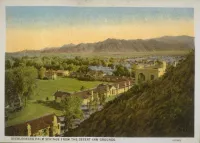
-

- Dave D
History of the Site
Pre-History Period For centuries Palm Springs was the home of the Agua Caliente Indians. As the site of natural hot springs and a dry and sunny desert climate, the area drew its first non-Indian visitors in the late 19th century. Of Palm Springs’ Pre-History Period the only remaining feature is the mineral hot springs that initially drew the Native Americans to the location. Of Irish descent, Nellie Norton Orr Coffman (1867-1950) was the owner of the land upon which the O’Donnell Residence was built. Nellie’s family moved to Dallas, Texas in 1877 because of her mother Ruth’s health. In Dallas, the twenty-year-old Nellie met and married building contractor George Ball Roberson in 1887. Several months later, Roberson tragically died in a fire shortly before his son George, Jr. was born. At that time, Nellie’s family had already moved to Los Angeles, California, where her father entered the hotel business. She joined them and, in 1889, she met Harry Coffman whom she married in 1891. Their son Earl was born in 1892. Coffman earned his medical degree in 1901, after which he established a medical practice in Santa Monica. Health issues also caused Nellie to explore a dryer climate. In 1909, the Coffmans purchased an existing residence and stable from B. W. and Mary McKenzie for $5,000, with a down payment of $2,000. It was here that they established a convalescent health care facility called the Desert Inn Sanatorium, with Dr. Coffman as the resident physician - he is considered the first practicing physician in Palm Springs. As the village grew up around the Desert Inn, the Coffmans expanded the property to include thirty-five acres: “twenty-seven on the flat, eight on the mountain." Theirs was an informed choice because, unlike other Palm Springs properties, this property had access to freshwater via the Tahquitz Flume that bordered the north end of the Coffman property. Within a few years, the Coffmans separated: Harry pursued his medical practice elsewhere while Nellie remained in Palm Springs and transformed the sanatorium/boarding house into a hotel. In 1914, they were divorced; Nellie and her sons retained ownership of the hotel. In 1920, Nellie began to formulate plans to expand the Desert Inn to a luxury resort and actively discouraged guests with respiratory or pulmonary ailments. She developed a “no invalid” policy and tent houses were replaced by wooden bungalows with screened porches. Anticipating the growth of the village, Nellie borrowed $35,000 from the Citizen's National Bank of Riverside to begin the first expansion of the hotel through the construction of the first concrete buildings in the compound beginning in 1922. During this period, the Desert Inn began to emerge as a haven for wealthy Los Angelinos, one of whom was multi-millionaire oil man Thomas O’Donnell, who became not only a regular visitor but also a close friend of Nellie Coffman. O’Donnell encouraged Coffman’s expansion plans by providing funding for new construction of the Inn in 1924 in the form of a $350,000 loan (the equivalent of $5,000,000 today). In exchange, Coffman agreed to lease part of the Desert Inn property (on the cliff overlooking the hotel) to O’Donnell for the construction of his own vacation home. That home is the subject of this nomination. The renewable 25-year lease covered 14.56 acres of mostly unbuildable land. Today the site of the O’Donnell Residence has been reduced to approximately one-half an acre.
History of the Site
Pre-History Period For centuries Palm Springs was the home of the Agua Caliente Indians. As the site of natural hot springs and a dry and sunny desert climate, the area drew its first non-Indian visitors in the late 19th century. Of Palm Springs’ Pre-History Period the only remaining feature is the mineral hot springs that initially drew the Native Americans to the location. Of Irish descent, Nellie Norton Orr Coffman (1867-1950) was the owner of the land upon which the O’Donnell Residence was built. Nellie’s family moved to Dallas, Texas in 1877 because of her mother Ruth’s health. In Dallas, the twenty-year-old Nellie met and married building contractor George Ball Roberson in 1887. Several months later, Roberson tragically died in a fire shortly before his son George, Jr. was born. At that time, Nellie’s family had already moved to Los Angeles, California, where her father entered the hotel business. She joined them and, in 1889, she met Harry Coffman whom she married in 1891. Their son Earl was born in 1892. Coffman earned his medical degree in 1901, after which he established a medical practice in Santa Monica. Health issues also caused Nellie to explore a dryer climate. In 1909, the Coffmans purchased an existing residence and stable from B. W. and Mary McKenzie for $5,000, with a down payment of $2,000. It was here that they established a convalescent health care facility called the Desert Inn Sanatorium, with Dr. Coffman as the resident physician - he is considered the first practicing physician in Palm Springs. As the village grew up around the Desert Inn, the Coffmans expanded the property to include thirty-five acres: “twenty-seven on the flat, eight on the mountain." Theirs was an informed choice because, unlike other Palm Springs properties, this property had access to freshwater via the Tahquitz Flume that bordered the north end of the Coffman property. Within a few years, the Coffmans separated: Harry pursued his medical practice elsewhere while Nellie remained in Palm Springs and transformed the sanatorium/boarding house into a hotel. In 1914, they were divorced; Nellie and her sons retained ownership of the hotel. In 1920, Nellie began to formulate plans to expand the Desert Inn to a luxury resort and actively discouraged guests with respiratory or pulmonary ailments. She developed a “no invalid” policy and tent houses were replaced by wooden bungalows with screened porches. Anticipating the growth of the village, Nellie borrowed $35,000 from the Citizen's National Bank of Riverside to begin the first expansion of the hotel through the construction of the first concrete buildings in the compound beginning in 1922. During this period, the Desert Inn began to emerge as a haven for wealthy Los Angelinos, one of whom was multi-millionaire oil man Thomas O’Donnell, who became not only a regular visitor but also a close friend of Nellie Coffman. O’Donnell encouraged Coffman’s expansion plans by providing funding for new construction of the Inn in 1924 in the form of a $350,000 loan (the equivalent of $5,000,000 today). In exchange, Coffman agreed to lease part of the Desert Inn property (on the cliff overlooking the hotel) to O’Donnell for the construction of his own vacation home. That home is the subject of this nomination. The renewable 25-year lease covered 14.56 acres of mostly unbuildable land. Today the site of the O’Donnell Residence has been reduced to approximately one-half an acre.
Jan 07, 2011
History of the Site
Pre-History Period For centuries Palm Springs was the home of the Agua Caliente Indians. As the site of natural hot springs and a dry and sunny desert climate, the area drew its first non-Indian visitors in the late 19th century. Of Palm Springs’ Pre-History Period the only remaining feature is the mineral hot springs that initially drew the Native Americans to the location.Of Irish descent, Nellie Norton Orr Coffman (1867-1950) was the owner of the land upon which the O’Donnell Residence was built. Nellie’s family moved to Dallas, Texas in 1877 because of her mother Ruth’s health. In Dallas, the twenty-year-old Nellie met and married building contractor George Ball Roberson in 1887. Several months later, Roberson tragically died in a fire shortly before his son George, Jr. was born. At that time, Nellie’s family had already moved to Los Angeles, California, where her father entered the hotel business. She joined them and, in 1889, she met Harry Coffman whom she married in 1891. Their son Earl was born in 1892. Coffman earned his medical degree in 1901, after which he established a medical practice in Santa Monica.
Health issues also caused Nellie to explore a dryer climate. In 1909, the Coffmans purchased an existing residence and stable from B. W. and Mary McKenzie for $5,000, with a down payment of $2,000. It was here that they established a convalescent health care facility called the Desert Inn Sanatorium, with Dr. Coffman as the resident physician - he is considered the first practicing physician in Palm Springs.
As the village grew up around the Desert Inn, the Coffmans expanded the property to include thirty-five acres: “twenty-seven on the flat, eight on the mountain." Theirs was an informed choice because, unlike other Palm Springs properties, this property had access to freshwater via the Tahquitz Flume that bordered the north end of the Coffman property.
Within a few years, the Coffmans separated: Harry pursued his medical practice elsewhere while Nellie remained in Palm Springs and transformed the sanatorium/boarding house into a hotel. In 1914, they were divorced; Nellie and her sons retained ownership of the hotel. In 1920, Nellie began to formulate plans to expand the Desert Inn to a luxury resort and actively discouraged guests with respiratory or pulmonary ailments. She developed a “no invalid” policy and tent houses were replaced by wooden bungalows with screened porches.
Anticipating the growth of the village, Nellie borrowed $35,000 from the Citizen's National Bank of Riverside to begin the first expansion of the hotel through the construction of the first concrete buildings in the compound beginning in 1922. During this period, the Desert Inn began to emerge as a haven for wealthy Los Angelinos, one of whom was multi-millionaire oil man Thomas O’Donnell, who became not only a regular visitor but also a close friend of Nellie Coffman.
O’Donnell encouraged Coffman’s expansion plans by providing funding for new construction of the Inn in 1924 in the form of a $350,000 loan (the equivalent of $5,000,000 today). In exchange, Coffman agreed to lease part of the Desert Inn property (on the cliff overlooking the hotel) to O’Donnell for the construction of his own vacation home. That home is the subject of this nomination. The renewable 25-year lease covered 14.56 acres of mostly unbuildable land. Today the site of the O’Donnell Residence has been reduced to approximately one-half an acre.
Posted Date
Dec 31, 2021
Historical Record Date
Jan 07, 2011
Source Name
United States Department of the Interior - National Park Service
Delete Story
Are you sure you want to delete this story?
Jan 07, 2011
Jan 07, 2011
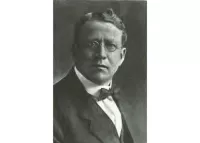
-

- Dave D
Who were the O'Donnell's?
Thomas Arthur O’Donnell was born at McCain, Pennsylvania, on June 26, 1870, the son of Thomas O’Donnell and Myra (Parsons) O’Donnell. In 1896, he married Lilly Woods. The marriage produced two daughters, Ruth and Doris. Although O’Donnell had little formal education, he was extremely industrious. By the age of 10, he had found work as a newsboy. Within a couple of years, he was drawn to the Colorado gold and oil region and soon found work as a laborer in the gold mines where he worked for five years, becoming a thoroughly experienced miner by the age of 19. In 1889 he moved to California and began working in the oil business. In 1894, O’Donnell formed an oil well drilling partnership with pioneer oilman M. H. Whittier. The partnership lasted for five years after which O’Donnell become an independent driller and oil land speculator. Within three years he controlled properties in California and Mexico. In 1902, he entered the Coalinga, California field, and his success there was among California’s most profitable on record. In 1909, O’Donnell and several other oilmen organized the American Oil Fields Company. O’Donnell was vice president and field manager of that corporation; he also held the same position in the American Petroleum Company. These two oil companies were among the largest independent producers in the United States. Although O’Donnell’s principal residence was in Long Beach/ from his first visits to the desert in the 1920s, he became a major benefactor and cultural force in the village who contributed substantial funding to the Palm Springs Library and the Palm Springs Museum. Upon his death, the O’Donnell Golf Course was bequeathed to the city with a long-term lease to the members of the golf club. In 1940, Thomas O’Donnell’s deteriorating health made climbing stairs in his Palm Springs home difficult. The situation was resolved by the construction of another house - this time only a single story - located on the flat land overlooking his beloved golf course. The O’Donnells lived in this valley house, until his death in 1945. The golf course property, including the valley house, was given to the city of Palm Springs Mrs. O’Donnell retired to their home in Long Beach where she resided until her death in 1969.
Who were the O'Donnell's?
Thomas Arthur O’Donnell was born at McCain, Pennsylvania, on June 26, 1870, the son of Thomas O’Donnell and Myra (Parsons) O’Donnell. In 1896, he married Lilly Woods. The marriage produced two daughters, Ruth and Doris. Although O’Donnell had little formal education, he was extremely industrious. By the age of 10, he had found work as a newsboy. Within a couple of years, he was drawn to the Colorado gold and oil region and soon found work as a laborer in the gold mines where he worked for five years, becoming a thoroughly experienced miner by the age of 19. In 1889 he moved to California and began working in the oil business. In 1894, O’Donnell formed an oil well drilling partnership with pioneer oilman M. H. Whittier. The partnership lasted for five years after which O’Donnell become an independent driller and oil land speculator. Within three years he controlled properties in California and Mexico. In 1902, he entered the Coalinga, California field, and his success there was among California’s most profitable on record. In 1909, O’Donnell and several other oilmen organized the American Oil Fields Company. O’Donnell was vice president and field manager of that corporation; he also held the same position in the American Petroleum Company. These two oil companies were among the largest independent producers in the United States. Although O’Donnell’s principal residence was in Long Beach/ from his first visits to the desert in the 1920s, he became a major benefactor and cultural force in the village who contributed substantial funding to the Palm Springs Library and the Palm Springs Museum. Upon his death, the O’Donnell Golf Course was bequeathed to the city with a long-term lease to the members of the golf club. In 1940, Thomas O’Donnell’s deteriorating health made climbing stairs in his Palm Springs home difficult. The situation was resolved by the construction of another house - this time only a single story - located on the flat land overlooking his beloved golf course. The O’Donnells lived in this valley house, until his death in 1945. The golf course property, including the valley house, was given to the city of Palm Springs Mrs. O’Donnell retired to their home in Long Beach where she resided until her death in 1969.
Who were the O'Donnell's?
Thomas Arthur O’Donnell was born at McCain, Pennsylvania, on June 26, 1870, the son of Thomas O’Donnell and Myra (Parsons) O’Donnell. In 1896, he married Lilly Woods. The marriage produced two daughters, Ruth and Doris. Although O’Donnell had little formal education, he was extremely industrious. By the age of 10, he had found work as a newsboy. Within a couple of years, he was drawn to the Colorado gold and oil region and soon found work as a laborer in the gold mines where he worked for five years, becoming a thoroughly experienced miner by the age of 19. In 1889 he moved to California and began working in the oil business. In 1894, O’Donnell formed an oil well drilling partnership with pioneer oilman M. H. Whittier. The partnership lasted for five years after which O’Donnell become an independent driller and oil land speculator. Within three years he controlled properties in California and Mexico. In 1902, he entered the Coalinga, California field, and his success there was among California’s most profitable on record. In 1909, O’Donnell and several other oilmen organized the American Oil Fields Company. O’Donnell was vice president and field manager of that corporation; he also held the same position in the American Petroleum Company. These two oil companies were among the largest independent producers in the United States.Although O’Donnell’s principal residence was in Long Beach/ from his first visits to the desert in the 1920s, he became a major benefactor and cultural force in the village who contributed substantial funding to the Palm Springs Library and the Palm Springs Museum. Upon his death, the O’Donnell Golf Course was bequeathed to the city with a long-term lease to the members of the golf club.
In 1940, Thomas O’Donnell’s deteriorating health made climbing stairs in his Palm Springs home difficult. The situation was resolved by the construction of another house - this time only a single story - located on the flat land overlooking his beloved golf course. The O’Donnells lived in this valley house, until his death in 1945. The golf course property, including the valley house, was given to the city of Palm Springs Mrs. O’Donnell retired to their home in Long Beach where she resided until her death in 1969.
Posted Date
Dec 31, 2021
Historical Record Date
Jan 07, 2011
Source Name
United States Department of the Interior - National Park Service
Delete Story
Are you sure you want to delete this story?
Jan 07, 2011
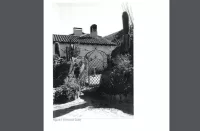
-

- Dave D
National Register of Historic Places - Summary
From the National Register of Historic Places Registration Form Summary: The 1925 Thomas O'Donnell Residence was the first Palm Springs building to be constructed above the valley floor on the lower slopes of Mf. San Jacinto. The steep hillside lot, approximately 200 feet above the village that, at the time was the highest elevation of any Coachella Valley building site. The site fans out to the south and west of the house to a lawn area bordered by boulders. A cactus garden that was established when the house was built is located near the house. The rear (west) facade was built within six feet of the sheer mountain face and cannot be easily viewed. The construction is of concrete block faced with cement plaster. Significant features include the floor plan, an L-shaped form surmounted by intersecting gable roof forms covered with variegated clay files in reds and browns. Other significant features are the trim-less, frameless windows and doors that are recessed into the thick masonry walls; they are constructed of wooden components and are single glazed. The curving balcony on the principal facade at the second level is also included among the building’s character-defining features. The two-story, four-bedroom, 4,100 square foot residence is approximately 100 feet long by 20 feet deep with an orientation that is about 15E out of north-south alignment, resulting in a structure whose principal facade faces southeast to maximize views from all of the rooms. The 150' x 150' site contains 22,500 square feet, roughly half an acre. A comparison between historic and contemporary photographs reveals the property is essentially unchanged from its original appearance with two exceptions: on the first floor, a roofed patio area has been enclosed with French doors, and on the second floor, an enclosed sundeck has been roofed over. These changes occurred in the 1940s and have acquired historic significance in their own right. As the last intact surviving structure of the Desert Inn complex, the building represents a development pattern that parallels Palm Springs’ growth from a tiny rural village to a city of national prominence. The building is the important surviving component of the large building compound known as the Desert Inn, the village’s first luxury resort hotel which fueled the growth of the village. Narrative: Setting: The O'Donnell residence is located on a steep hillside lot, approximately 200 feet above the Coachella Valley floor. The 22,500 square foot site is accessed by a private road flanked by two wrought iron gates. The smaller gate [Figure 1] leads to the house; the larger gates [Figure 2] lead to a paved motor court. South and west of the house, there is a lawn bordered by boulders and a walled garden accessed via a rock archway. An original cactus garden lies at the southeast corner of the house. The nearly invisible west facade of the house lies within six feet of the mountain face. Building; The O’Donnell residence is a surprisingly modest home considering the wealth of its owner. The two-story, ell-shaped four-bedroom, 4,100 square foot residence is approximately 100 feet long by 20 feet deep. The principal facade [Figure 3] faces southeast to maximize views from all rooms. The house was built in a hybrid Spanish Colonial Revival / Monterey style; such buildings are often called "Hollywood Spanish.” The Monterey-style balcony projecting along the front of the facade may be the most character-defining feature of the building. The balcony's fret-cut balusters and curving end are more elaborate than those usually found on buildings in this style. The building displays other Spanish Colonial stylistic markers including plain cement plaster walls, a clay tile roof, wrought-iron gates, and window grills, and brightly colored ceramic tiles in the bathrooms and kitchen. In addition to the extensive use of tiles from Malibu Tile, Gladding McBean and Batchelder can also be found. Arriving at the small wrought-iron gate, a visitor passes through a small courtyard paved with cobblestones of different colors arranged in delicate curves. On the other side of the courtyard, the North elevation contains the main entrance door. Visitors enter directly into the tall 20' x 30’ living room [Figure 4] located in the shorter leg of the ell. The room is approximately 25' tall with an exposed wooden truss ceiling. The regular height kitchen lies at the far end of the living room, separated from that room by an enclosed stair that leads to the upper level of the adjacent wing. Here on the second level are the owner’s bedrooms, tiled bathrooms, and dressing rooms outfitted with mirrors, cabinets, and built-in drawers. The doors of the bedrooms open onto balconies, which were used as sleeping porches. Each bedroom has a fireplace. A sundeck, at the far southern end of the bedroom wing, was originally framed with hand-adzed oak columns and beams from which curtains were hung for wind protection and privacy. Today, the sundeck has been roofed over and the openings glazed to allow the room’s use as an additional bedroom. On the first floor, at the intersection of the two wings, a roofed porch was originally used as an indoor-outdoor room. Today, this space has been enclosed with French doors to allow year-round use. The lower level of the bedroom wing contains two guest bedrooms, each with a tiled bath and dressing area. French doors open onto a paved walkway. Construction is of concrete block faced with cement plaster that gives the appearance of adobe on both the interior and exterior. The intersecting gable roof forms are covered with variegated clay tile in reds and browns. The home’s single-glazed wooden windows and doors are frameless, and trimless, and recessed into the thick masonry walls. The building contains a series of chimneys, all but one of which are simple rectangular forms topped with metal spark deflectors. The large chimney above the living room fireplace has more elaborate Moorish-inspired detailing. The walls were originally colored a greenish-gray and the woodwork was stained black, unlike the stark white usually associated with this style. The living-room features Spanish details in the interior doors, the hooded fireplace, and the overhanging balconette. A large arched window flanked by two matching doors defines the east end. Each French door is subdivided into four vertical lites. On the south side, additional French doors open to the roofed open-air living/dining area. Outbuildings: Cut into the mountain rock, a small garage that was part of the original construction is essentially unseen, except for a pair of painted wood garage doors. Too small for today’s automobiles, the space is now used for storage. [Figure 5] Landscape features: A switchback path from the Desert Inn that led up to the O’Donnell house is said to have been used twice daily as Nellie Coffman personally monitored the construction of the O’Donnell house. In later years it was used by the public to climb the mountain for Easter Sunrise services held annually on the site. In addition to the previously cited entrance drive, and the cactus garden and motor court, a retaining wall along the south end of the property was created to allow a flat outdoor space. A green lawn, bordered by boulders leads to an expanse of lawn and a rock archway that provides access to the former laundry drying yard used by the O’Donnell housekeeper; today this area is a “secret” walled garden. Integrity: After having gone through a period of decline, the property was purchased by the current owners who embarked upon a thorough restoration program. The current condition of the property is excellent. A few minor changes that have occurred to the building are noted below: The second-floor room on the south end of the house was originally a roofless sundeck that v^as also used as a sleeping porch. It had no windows and was screened from the breeze through the use of canvas awnings in wooden frames. Today, the space has been roofed over and converted into an enclosed bedroom. The roofed outdoor living/dining area was originally shielded from the elements through the use of large canvas awnings. In the 1940s, it was enclosed with pairs of French doors that resemble those found elsewhere on the house. Along the south elevation, there exists a stone stairway that provided access from the garden to the sunroof. It is in original condition, although pipe handrails have been added. Interior changes: The original balconette in the living room has been replaced with a simpler version. There is no explanation as to the loss of the original, which was a finely-detailed example of the type often found in Spanish churches. Two doors at the west end of the living room were removed in the 1940s. Replicas, based upon photographic evidence, were fabricated and installed. An evaluation of the building's integrity indicates that in spite of the minor changes cited, the building still retains the integrity of location, materials, and workmanship. The changes in the original construction are insufficient to compromise its design, and although the Desert Inn, of which it was a part, is gone, the hillside setting remains essentially unchanged. The subject property retains sufficient integrity to qualify for listing on the National Register.
National Register of Historic Places - Summary
From the National Register of Historic Places Registration Form Summary: The 1925 Thomas O'Donnell Residence was the first Palm Springs building to be constructed above the valley floor on the lower slopes of Mf. San Jacinto. The steep hillside lot, approximately 200 feet above the village that, at the time was the highest elevation of any Coachella Valley building site. The site fans out to the south and west of the house to a lawn area bordered by boulders. A cactus garden that was established when the house was built is located near the house. The rear (west) facade was built within six feet of the sheer mountain face and cannot be easily viewed. The construction is of concrete block faced with cement plaster. Significant features include the floor plan, an L-shaped form surmounted by intersecting gable roof forms covered with variegated clay files in reds and browns. Other significant features are the trim-less, frameless windows and doors that are recessed into the thick masonry walls; they are constructed of wooden components and are single glazed. The curving balcony on the principal facade at the second level is also included among the building’s character-defining features. The two-story, four-bedroom, 4,100 square foot residence is approximately 100 feet long by 20 feet deep with an orientation that is about 15E out of north-south alignment, resulting in a structure whose principal facade faces southeast to maximize views from all of the rooms. The 150' x 150' site contains 22,500 square feet, roughly half an acre. A comparison between historic and contemporary photographs reveals the property is essentially unchanged from its original appearance with two exceptions: on the first floor, a roofed patio area has been enclosed with French doors, and on the second floor, an enclosed sundeck has been roofed over. These changes occurred in the 1940s and have acquired historic significance in their own right. As the last intact surviving structure of the Desert Inn complex, the building represents a development pattern that parallels Palm Springs’ growth from a tiny rural village to a city of national prominence. The building is the important surviving component of the large building compound known as the Desert Inn, the village’s first luxury resort hotel which fueled the growth of the village. Narrative: Setting: The O'Donnell residence is located on a steep hillside lot, approximately 200 feet above the Coachella Valley floor. The 22,500 square foot site is accessed by a private road flanked by two wrought iron gates. The smaller gate [Figure 1] leads to the house; the larger gates [Figure 2] lead to a paved motor court. South and west of the house, there is a lawn bordered by boulders and a walled garden accessed via a rock archway. An original cactus garden lies at the southeast corner of the house. The nearly invisible west facade of the house lies within six feet of the mountain face. Building; The O’Donnell residence is a surprisingly modest home considering the wealth of its owner. The two-story, ell-shaped four-bedroom, 4,100 square foot residence is approximately 100 feet long by 20 feet deep. The principal facade [Figure 3] faces southeast to maximize views from all rooms. The house was built in a hybrid Spanish Colonial Revival / Monterey style; such buildings are often called "Hollywood Spanish.” The Monterey-style balcony projecting along the front of the facade may be the most character-defining feature of the building. The balcony's fret-cut balusters and curving end are more elaborate than those usually found on buildings in this style. The building displays other Spanish Colonial stylistic markers including plain cement plaster walls, a clay tile roof, wrought-iron gates, and window grills, and brightly colored ceramic tiles in the bathrooms and kitchen. In addition to the extensive use of tiles from Malibu Tile, Gladding McBean and Batchelder can also be found. Arriving at the small wrought-iron gate, a visitor passes through a small courtyard paved with cobblestones of different colors arranged in delicate curves. On the other side of the courtyard, the North elevation contains the main entrance door. Visitors enter directly into the tall 20' x 30’ living room [Figure 4] located in the shorter leg of the ell. The room is approximately 25' tall with an exposed wooden truss ceiling. The regular height kitchen lies at the far end of the living room, separated from that room by an enclosed stair that leads to the upper level of the adjacent wing. Here on the second level are the owner’s bedrooms, tiled bathrooms, and dressing rooms outfitted with mirrors, cabinets, and built-in drawers. The doors of the bedrooms open onto balconies, which were used as sleeping porches. Each bedroom has a fireplace. A sundeck, at the far southern end of the bedroom wing, was originally framed with hand-adzed oak columns and beams from which curtains were hung for wind protection and privacy. Today, the sundeck has been roofed over and the openings glazed to allow the room’s use as an additional bedroom. On the first floor, at the intersection of the two wings, a roofed porch was originally used as an indoor-outdoor room. Today, this space has been enclosed with French doors to allow year-round use. The lower level of the bedroom wing contains two guest bedrooms, each with a tiled bath and dressing area. French doors open onto a paved walkway. Construction is of concrete block faced with cement plaster that gives the appearance of adobe on both the interior and exterior. The intersecting gable roof forms are covered with variegated clay tile in reds and browns. The home’s single-glazed wooden windows and doors are frameless, and trimless, and recessed into the thick masonry walls. The building contains a series of chimneys, all but one of which are simple rectangular forms topped with metal spark deflectors. The large chimney above the living room fireplace has more elaborate Moorish-inspired detailing. The walls were originally colored a greenish-gray and the woodwork was stained black, unlike the stark white usually associated with this style. The living-room features Spanish details in the interior doors, the hooded fireplace, and the overhanging balconette. A large arched window flanked by two matching doors defines the east end. Each French door is subdivided into four vertical lites. On the south side, additional French doors open to the roofed open-air living/dining area. Outbuildings: Cut into the mountain rock, a small garage that was part of the original construction is essentially unseen, except for a pair of painted wood garage doors. Too small for today’s automobiles, the space is now used for storage. [Figure 5] Landscape features: A switchback path from the Desert Inn that led up to the O’Donnell house is said to have been used twice daily as Nellie Coffman personally monitored the construction of the O’Donnell house. In later years it was used by the public to climb the mountain for Easter Sunrise services held annually on the site. In addition to the previously cited entrance drive, and the cactus garden and motor court, a retaining wall along the south end of the property was created to allow a flat outdoor space. A green lawn, bordered by boulders leads to an expanse of lawn and a rock archway that provides access to the former laundry drying yard used by the O’Donnell housekeeper; today this area is a “secret” walled garden. Integrity: After having gone through a period of decline, the property was purchased by the current owners who embarked upon a thorough restoration program. The current condition of the property is excellent. A few minor changes that have occurred to the building are noted below: The second-floor room on the south end of the house was originally a roofless sundeck that v^as also used as a sleeping porch. It had no windows and was screened from the breeze through the use of canvas awnings in wooden frames. Today, the space has been roofed over and converted into an enclosed bedroom. The roofed outdoor living/dining area was originally shielded from the elements through the use of large canvas awnings. In the 1940s, it was enclosed with pairs of French doors that resemble those found elsewhere on the house. Along the south elevation, there exists a stone stairway that provided access from the garden to the sunroof. It is in original condition, although pipe handrails have been added. Interior changes: The original balconette in the living room has been replaced with a simpler version. There is no explanation as to the loss of the original, which was a finely-detailed example of the type often found in Spanish churches. Two doors at the west end of the living room were removed in the 1940s. Replicas, based upon photographic evidence, were fabricated and installed. An evaluation of the building's integrity indicates that in spite of the minor changes cited, the building still retains the integrity of location, materials, and workmanship. The changes in the original construction are insufficient to compromise its design, and although the Desert Inn, of which it was a part, is gone, the hillside setting remains essentially unchanged. The subject property retains sufficient integrity to qualify for listing on the National Register.
Jan 07, 2011
National Register of Historic Places - Summary
From the National Register of Historic Places Registration FormSummary:
The 1925 Thomas O'Donnell Residence was the first Palm Springs building to
be constructed above the valley floor on the lower slopes of Mf. San Jacinto. The steep hillside lot, approximately 200 feet above the village that, at the time was the highest elevation of any Coachella Valley building site. The site fans out to the south and west of the house to a lawn area bordered by boulders. A cactus garden that was established when the house was built is located near the house. The rear (west) facade was built within six feet of the sheer mountain face and cannot be easily viewed. The construction is of concrete block faced with cement plaster. Significant features include the floor plan, an L-shaped form surmounted by intersecting gable roof forms covered with variegated clay files in reds and browns. Other significant features are the trim-less, frameless windows and doors that are recessed into the thick masonry walls; they are constructed of wooden components and are single glazed. The curving balcony on the principal facade at the second level is also included among the building’s character-defining features. The two-story, four-bedroom, 4,100 square foot residence is approximately 100 feet long by 20 feet deep with an orientation that is about 15E out of north-south alignment, resulting in a structure whose principal facade faces southeast to maximize views from all of the rooms. The 150' x 150' site contains 22,500 square feet, roughly half an acre. A comparison between historic and contemporary photographs reveals the property is essentially unchanged from its original appearance with two exceptions: on the first floor, a roofed patio area has been enclosed with French doors, and on the second floor, an enclosed sundeck has been roofed over. These changes occurred in the 1940s and have acquired historic significance in their own right. As the last intact surviving structure of the Desert Inn complex, the building represents a development pattern that parallels Palm Springs’ growth from a tiny rural village to a city of national prominence. The building is the important surviving component of the large building compound known as the Desert Inn, the village’s first luxury resort hotel which fueled the growth of the village.
Narrative:
Setting:
The O'Donnell residence is located on a steep hillside lot, approximately 200 feet above the Coachella Valley floor. The 22,500 square foot site is accessed by a private road flanked by two wrought iron gates. The smaller gate [Figure 1] leads to the house; the larger gates [Figure 2] lead to a paved motor court. South and west of the house, there is a lawn bordered by boulders and a walled garden accessed via a rock archway. An original cactus garden lies at the southeast corner of the house. The nearly invisible west facade of the house lies within six feet of the mountain face.
Building;
The O’Donnell residence is a surprisingly modest home considering the wealth of its owner. The two-story, ell-shaped four-bedroom, 4,100 square foot residence is approximately 100 feet long by 20 feet deep. The principal facade [Figure 3] faces southeast to maximize views from all rooms. The house was built in a hybrid Spanish Colonial Revival / Monterey style; such buildings are often called "Hollywood Spanish.” The Monterey-style balcony projecting along the front of the facade may be the most character-defining feature of the building. The balcony's fret-cut balusters and curving end are more elaborate
than those usually found on buildings in this style. The building displays
other Spanish Colonial stylistic markers including plain cement plaster
walls, a clay tile roof, wrought-iron gates, and window grills, and brightly colored ceramic tiles in the bathrooms and kitchen. In addition to the extensive use of tiles from Malibu Tile, Gladding McBean and Batchelder can also be found.
Arriving at the small wrought-iron gate, a visitor passes through a small courtyard paved with cobblestones of different colors arranged in delicate curves. On the other side of the courtyard, the North elevation contains the main entrance door. Visitors enter directly into the tall 20' x 30’ living room [Figure 4] located in the shorter leg of the ell. The room is approximately 25' tall with an exposed wooden truss ceiling. The regular height kitchen lies at the far end of the living room, separated from that room by an enclosed stair that leads to the upper level of the adjacent wing. Here on the second level are the owner’s bedrooms, tiled bathrooms, and dressing rooms outfitted with mirrors, cabinets, and built-in drawers. The doors of the bedrooms open onto balconies, which were used as sleeping porches. Each bedroom has a fireplace. A sundeck, at the far southern end of the bedroom wing, was originally framed with hand-adzed oak columns and beams from which curtains were hung for wind protection and privacy. Today, the sundeck has been roofed over and the openings glazed to allow the room’s use as an additional bedroom.
On the first floor, at the intersection of the two wings, a roofed porch was originally used as an indoor-outdoor room. Today, this space has been enclosed with French doors to allow year-round use. The lower level of the bedroom wing contains two guest bedrooms, each with a tiled bath and dressing area. French doors open onto a paved walkway.
Construction is of concrete block faced with cement plaster that gives the appearance of adobe on both the interior and exterior. The intersecting gable roof forms are covered with variegated clay tile in reds and browns. The home’s single-glazed wooden windows and doors are frameless, and trimless, and recessed into the thick masonry walls. The building contains a series of chimneys, all but one of which are simple rectangular forms topped with metal spark deflectors. The large chimney above the living room fireplace has more elaborate Moorish-inspired detailing.
The walls were originally colored a greenish-gray and the woodwork was stained black, unlike the stark white usually associated with this style. The living-room features Spanish details in the interior doors, the hooded fireplace, and the overhanging balconette. A large arched window flanked by two matching doors defines the east end. Each French door is subdivided into four vertical lites. On the south side, additional French doors open to the roofed open-air living/dining area.
Outbuildings:
Cut into the mountain rock, a small garage that was part of the original construction is essentially unseen, except for a pair of painted wood garage doors. Too small for today’s automobiles, the space is now used for storage. [Figure 5]
Landscape features:
A switchback path from the Desert Inn that led up to the O’Donnell house is said to have been used twice daily as Nellie Coffman personally monitored the construction of the O’Donnell house. In later years it was used by the public to climb the mountain for Easter Sunrise services held annually on the site. In addition to the previously cited entrance drive, and the cactus garden and motor court, a retaining wall along the south end of the property was created to allow a flat outdoor space. A green lawn, bordered by boulders leads to an expanse of lawn and a rock archway that provides access to the former laundry drying yard used by the O’Donnell housekeeper; today this area is a “secret” walled garden.
Integrity:
After having gone through a period of decline, the property was purchased by the current owners who embarked upon a thorough restoration program. The current condition of the property is excellent. A few minor changes that have occurred to the building are noted below:
The second-floor room on the south end of the house was originally a roofless sundeck that v^as also used as a sleeping porch. It had no windows and was screened from the breeze through the use of canvas awnings in wooden frames. Today, the space has been roofed over and converted into an enclosed bedroom.
The roofed outdoor living/dining area was originally shielded from the elements through the use of large canvas awnings. In the 1940s, it was enclosed with pairs of French doors that resemble those found elsewhere on the house. Along the south elevation, there exists a stone stairway that provided access from the garden to the sunroof. It is in original condition, although pipe handrails have been added.
Interior changes: The original balconette in the living room has been replaced with a simpler version. There is no explanation as to the loss of the original, which was a finely-detailed example of the type often found in Spanish churches. Two doors at the west end of the living room were removed in the 1940s. Replicas, based upon photographic evidence, were fabricated and installed.
An evaluation of the building's integrity indicates that in spite of the minor changes cited, the building still retains the integrity of location, materials, and workmanship. The changes in the original construction are insufficient to compromise its design, and although the Desert Inn, of which it was a part, is gone, the hillside setting remains essentially unchanged. The subject property retains sufficient integrity to qualify for listing on the National Register.
Posted Date
Dec 31, 2021
Historical Record Date
Jan 07, 2011
Source Name
United States Department of the Interior - National Park Service
Delete Story
Are you sure you want to delete this story?
Jul 01, 1928
Jul 01, 1928
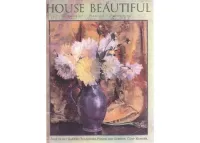
-

- Dave D
Ojo Del Desierto in The House Beautiful magazine
Story from The House Beautiful magazine was originally published in July 1928. Oro Del Desierto - The home of Mr. and Mrs. Thomas A. O'Donnell, in Southern California, of which W.C. Tanner was the Architect by Mary Kellogg For the ascent, to 'Ojo del Desierto' the Professor started the car in low. This is the highest compliment which he can pay to a hill - although such a 'hill,' it must hastily be admitted, is not to be mentioned in the same breath with the smiling, dimpled, the dured slopes of our New England. This hill is a full-fledged California mountain. It rises as abruptly from the floor of the desert as doubt some times rises in a mind prepared for action. It is also a sort of private mountain since it is the magnificent site for one house only. And there is probably only one person alive who would have conceived the gorgeous idea of building a house here, half way between heaven and earth, on a 'cloud loved terrace beyond the world.' A terrace reached by as superb a stretch of roadway as even the United States Government could build for its armies provided it possessed them. A roadway with a grade which caused even the Professor to pause, a thing he had not done from Vancouver to Tijuana, and begin the ascent in low. Even at that my eyes sought - just as Colonel Lindbergh's might, in a manner not reflecting upon courage but crediting prudence - desirable landing places. Upon a previous occasion, the car had slipped down a mountain backward. My opening paragraph will die without having lived if it has failed to convey an impression of the heights to which one goes to reach this almost unimaginable 'Eye of the Desert'; or of the sense of adventure and unreality which there attend one. The road, of course, is so care fully engineered and constructed that fears arc futile. One cannot fail to reach with case and safety the delicately wrought iron gates were the words 'Ojo del Desierto' silhouetted against the sky. Literally against the sky! Try to picture it, for otherwise no adequate conception of the peculiar loveliness of situation can be obtained. The mountain rises, sheer, from the California Desert of the Colorado River, rubbing shoulders with San Jacinto of purple shadows and ermine snows. (No wonder the ancient kings decided upon velvet and ermine before mode-forecasting periodicals were invented and when Nature supplied the only fashion hints.) Below the mountain are deserts that are not always, but sometimes, dry. Deserts which in springtime are violet oceans of verbenas, punctuated with yuccas of parchment white, Cactus blossoms of flaming coral, velvet spears of indigo bushes, misty smoke trees of pinkish pearl, and Palos Verdes of apple green. In this fantastic scene of magnificent distances the desert groves of orange and grapefruit trees, featuring globes of gold in black-green setting, seem as prim as our New England Cedars; while the drifts of luxuriant oleanders seem as chastely voluptuous as the warm-hued up upholstery our Pilgrims chose for their churches. The visitor to the desert must adopt a scale of new values. He must accept its strangenesses as cheerfully as an unexpected legacy, must compare it with nothing, and enjoy it 'as the nymphs do'. Or, if possessing the means, the leisure, and the inspiration, he might set a house like this one under the stars and be content. 'Ojo del Desierto' has been so designed that it seems to settle into its mountain site without hurting the mountain, which is a good deal for a house to accomplish. The adobe walls have been colored a greenish-gray to match the stone slopes, - this mountain has no verdure, - the woodwork has been blacked to match the shadows, and the tiles of the roof are stained pink to match the sunset glows. In fact, from the desert floor the structure seems to be as much a part of the craggy masses of rock as the exquisitely turreted chateaux of medieval France seem to belong to, and complement, their miniature mountain peaks. The house is built as a desert report, but it has architectural high lights which would glow equally well in other places and climes. These features are its outdoor dining room, its tiled kitchen, its sun-bathing roof, and its division into one-story and two-story sections. This division, in California, is quite a common one, a division of endless combinations and possibilities. It allows such. Such a manner of the building is, naturally, more suited to tropic than to temperate zones. But even in the latter the 'unit' system of California can be utilized with satisfactory results. In other words, one part of the house may be unheated during the greatest cold, provided the owner's need of will allow. That has been our way, the Professor's and mine, of accomplishing a house with a right angle. Hedge, arbor, and garden finish out our square. The right angle is not exactly a new idea, either, if compared with the old-fashioned ell. An ell built out at one side refuses to be a retiring creature like those built out at the rear and boldly invests itself with a sort of rakish charm. The Spanish living room of 'Ojo del Desierto' is a two-storied apartment with exposed timbers. It is used for an evening room - the desert nights are unbelievably cold - or during the very few winter days of desert rain. There is a lofty, hooded fireplace, and an overhanging balcony. At one end, overlooking that part of the desert known as 'the playground of the winds,' a glistening pane of heavy glass has been set into the wall. At the sides of this window, and in perfect scale, are twin doors opening out to the terrace. On the side, walls are two similar doors, exactly opposite each other. These open to the Cactus garden and outdoor dining room. Thus, with open doors, the living room becomes a terrace and the terrace becomes a living room, till one can scarcely decide which ‘dear charmer’ to love. The apple greens and Gobelin blues of the splendid tapestries of the room, the flickering beams of tallow drips in priceless antique candelabra, seem to reduce, almost to the scale of lares and penates, the marvelous sunsets and starlights of the desert. The outdoor room – half living, half dining – is in sharpest contrast to the cathedral-like dimness of the other. Here, under the burning sunlight of winter days, are spread crude yellows, reds, and black, in stripes and squares and other geometrical designs which only a scientist could name or an Indian employ. Elsewhere I have mentioned the value of having oriental chairs of wicker, upholstered in materials which nearly match them in color. This is done here, pale yellow linen being used and piped with black designs. The Indian rugs are black and white and red and yellow. There is a corner fireplace. Could any other be more lovely? Or more practical, since the fanlike contour of enclosing walls projects the heat into the room? Vivid strings of chilies limn themselves in broken vermillion lines on the adobe wall. A rattler has sacrificed its skin to make a background for a lily. This skin with its geometrical markings in grays and black suggests that the designs of the Hopi rugs have a background of natural history. Urns of color and of brightly burnished brass hold Cacti and grasses of upright and drooping habit. While from the nearby canyons have been brought palms – the sentinels of the desert and the most northern native species – in order that the edge of the terrace may be magnificently defined. They have been carried up the steep ascent by heaven only knows what powerful tractors and one wonders if ever in history such gigantic tropic plants have loomed in greater majesty against a more brilliant sky. Now we must – as I once heard the presiding officer of women’s club say, after the featured speaker was through – ‘come down to the mundane things of earth earthly and have a dish of tea.’ In other words, descend from the sky to the service kitchen. But it is far from being a descensus Averno because of the Spanish tiles which decore the way. A small door leads from the outdoor living-and-dining room to the serving-room, so disguised that only its architect would ever recognize it. To be perfectly honest, the first time I saw it I had no idea for what purpose it had been built! Just a lovely blue-tiled room, like a bathroom without fixtures. Doors and drawers and cupboards, however, conceal such perfection of electrical equipment that one believes anything might be true, and that it is only necessary to drop an electrified hook and line out of the smalled grilled window to capture grenouilles sautess a la bourgeoise. Inside stairs, outside ones too, lead to balconies and to sleeping-rooms having tiled bathrooms almost as delightful as the kitchen! Bathrooms which are dressing rooms as well, with mirrors and cabinets and oceans of drawers built into their walls. The doors of the bedrooms, opening out to balconies, convert them to sleeping porches at night, and back to rooms in the daytime. In colder climates, this is not quite practical, but the general idea of small sleeping-rooms and large bathrooms and outside porches is good for all. The large sleeping -rooms which we of New England, for instance, are accustomed to build and to open out to the zero winter nights might much better be divided in half, one section designed to be cold at night and one to be warm in the morning! The treasure of treasures is on the roof: a sun-bathing apartment. Frames of weathered, hand-adzed oak enclose and divide it. From these frames bright curtains are hung for protection, but, with only one residence to a mountain and in an enlightened corner of the country where sunbaths are accepted as a desirable habit and not as a freakish whim, there is no fear of censorious neighbors. One need not, in the Southwest, sneak off to a sunbath as to ‘the old swimmin’ hole’ of New England. One wonders if the baths of Caracalla ever dreamed of a rival in the sun! The Cactus garden is so unique a feature that it must not be passed over in describing this house. It is in a rocky depression which adjoins the Spanish room. One of the long, grilled doorways leads out to it from that room and exquisitely wrought iron gateway leads into it from the drive. The floor is made of flat stones laid up in cement, and has sections, in the Spanish manner, of small cobblestone of different colors arranged in delicate curves. The Marshfield beach yields just such cobbles, small and in shades of violet, rose, green, or gray. So one need not go to California or Spain in order that stone terraces may be thus decorated. The flora, however, are strictly desert blooms. Or, to be more exact, in some cases mere spiky spines. But spines of such interesting shape or color or habit that a desert lover aches to place them where they throw themselves or other plants into relief. All the plants of the desert protect themselves from the advances of such animals as would break their outward shells and deprive them of the tiny reservoirs of moisture so miraculously stored against periods of drought. These coverings, however, which are so cruel a nature, have – as may be noted in the photographs – an appearance of softness such as entirely belies their purpose. It is just this delicate outline – catching the light in unimaginable ways and combined with their curious forms – which gives them their value as domesticated plants. Moreover, their colors, of modest gray and misty green, are subtle and intriguing, while the blossoms which burst from their forbidding exteriors are of living flame and indigo of glowing red and coral. Or of yellow as pallid as white. Or of white as pallid as parchment. These Cacti seem to epitomize all the mystery, all the beauty, all the cruelty incarnate, all the tragedy and haunting charm of desert places. Just as they epitomize the pervading sense of unreality which invests the lovely ‘Eye of the Desert’. On that cloud-loved terrace beyond the world, where earth is forgotten and time lies dead.
Ojo Del Desierto in The House Beautiful magazine
Story from The House Beautiful magazine was originally published in July 1928. Oro Del Desierto - The home of Mr. and Mrs. Thomas A. O'Donnell, in Southern California, of which W.C. Tanner was the Architect by Mary Kellogg For the ascent, to 'Ojo del Desierto' the Professor started the car in low. This is the highest compliment which he can pay to a hill - although such a 'hill,' it must hastily be admitted, is not to be mentioned in the same breath with the smiling, dimpled, the dured slopes of our New England. This hill is a full-fledged California mountain. It rises as abruptly from the floor of the desert as doubt some times rises in a mind prepared for action. It is also a sort of private mountain since it is the magnificent site for one house only. And there is probably only one person alive who would have conceived the gorgeous idea of building a house here, half way between heaven and earth, on a 'cloud loved terrace beyond the world.' A terrace reached by as superb a stretch of roadway as even the United States Government could build for its armies provided it possessed them. A roadway with a grade which caused even the Professor to pause, a thing he had not done from Vancouver to Tijuana, and begin the ascent in low. Even at that my eyes sought - just as Colonel Lindbergh's might, in a manner not reflecting upon courage but crediting prudence - desirable landing places. Upon a previous occasion, the car had slipped down a mountain backward. My opening paragraph will die without having lived if it has failed to convey an impression of the heights to which one goes to reach this almost unimaginable 'Eye of the Desert'; or of the sense of adventure and unreality which there attend one. The road, of course, is so care fully engineered and constructed that fears arc futile. One cannot fail to reach with case and safety the delicately wrought iron gates were the words 'Ojo del Desierto' silhouetted against the sky. Literally against the sky! Try to picture it, for otherwise no adequate conception of the peculiar loveliness of situation can be obtained. The mountain rises, sheer, from the California Desert of the Colorado River, rubbing shoulders with San Jacinto of purple shadows and ermine snows. (No wonder the ancient kings decided upon velvet and ermine before mode-forecasting periodicals were invented and when Nature supplied the only fashion hints.) Below the mountain are deserts that are not always, but sometimes, dry. Deserts which in springtime are violet oceans of verbenas, punctuated with yuccas of parchment white, Cactus blossoms of flaming coral, velvet spears of indigo bushes, misty smoke trees of pinkish pearl, and Palos Verdes of apple green. In this fantastic scene of magnificent distances the desert groves of orange and grapefruit trees, featuring globes of gold in black-green setting, seem as prim as our New England Cedars; while the drifts of luxuriant oleanders seem as chastely voluptuous as the warm-hued up upholstery our Pilgrims chose for their churches. The visitor to the desert must adopt a scale of new values. He must accept its strangenesses as cheerfully as an unexpected legacy, must compare it with nothing, and enjoy it 'as the nymphs do'. Or, if possessing the means, the leisure, and the inspiration, he might set a house like this one under the stars and be content. 'Ojo del Desierto' has been so designed that it seems to settle into its mountain site without hurting the mountain, which is a good deal for a house to accomplish. The adobe walls have been colored a greenish-gray to match the stone slopes, - this mountain has no verdure, - the woodwork has been blacked to match the shadows, and the tiles of the roof are stained pink to match the sunset glows. In fact, from the desert floor the structure seems to be as much a part of the craggy masses of rock as the exquisitely turreted chateaux of medieval France seem to belong to, and complement, their miniature mountain peaks. The house is built as a desert report, but it has architectural high lights which would glow equally well in other places and climes. These features are its outdoor dining room, its tiled kitchen, its sun-bathing roof, and its division into one-story and two-story sections. This division, in California, is quite a common one, a division of endless combinations and possibilities. It allows such. Such a manner of the building is, naturally, more suited to tropic than to temperate zones. But even in the latter the 'unit' system of California can be utilized with satisfactory results. In other words, one part of the house may be unheated during the greatest cold, provided the owner's need of will allow. That has been our way, the Professor's and mine, of accomplishing a house with a right angle. Hedge, arbor, and garden finish out our square. The right angle is not exactly a new idea, either, if compared with the old-fashioned ell. An ell built out at one side refuses to be a retiring creature like those built out at the rear and boldly invests itself with a sort of rakish charm. The Spanish living room of 'Ojo del Desierto' is a two-storied apartment with exposed timbers. It is used for an evening room - the desert nights are unbelievably cold - or during the very few winter days of desert rain. There is a lofty, hooded fireplace, and an overhanging balcony. At one end, overlooking that part of the desert known as 'the playground of the winds,' a glistening pane of heavy glass has been set into the wall. At the sides of this window, and in perfect scale, are twin doors opening out to the terrace. On the side, walls are two similar doors, exactly opposite each other. These open to the Cactus garden and outdoor dining room. Thus, with open doors, the living room becomes a terrace and the terrace becomes a living room, till one can scarcely decide which ‘dear charmer’ to love. The apple greens and Gobelin blues of the splendid tapestries of the room, the flickering beams of tallow drips in priceless antique candelabra, seem to reduce, almost to the scale of lares and penates, the marvelous sunsets and starlights of the desert. The outdoor room – half living, half dining – is in sharpest contrast to the cathedral-like dimness of the other. Here, under the burning sunlight of winter days, are spread crude yellows, reds, and black, in stripes and squares and other geometrical designs which only a scientist could name or an Indian employ. Elsewhere I have mentioned the value of having oriental chairs of wicker, upholstered in materials which nearly match them in color. This is done here, pale yellow linen being used and piped with black designs. The Indian rugs are black and white and red and yellow. There is a corner fireplace. Could any other be more lovely? Or more practical, since the fanlike contour of enclosing walls projects the heat into the room? Vivid strings of chilies limn themselves in broken vermillion lines on the adobe wall. A rattler has sacrificed its skin to make a background for a lily. This skin with its geometrical markings in grays and black suggests that the designs of the Hopi rugs have a background of natural history. Urns of color and of brightly burnished brass hold Cacti and grasses of upright and drooping habit. While from the nearby canyons have been brought palms – the sentinels of the desert and the most northern native species – in order that the edge of the terrace may be magnificently defined. They have been carried up the steep ascent by heaven only knows what powerful tractors and one wonders if ever in history such gigantic tropic plants have loomed in greater majesty against a more brilliant sky. Now we must – as I once heard the presiding officer of women’s club say, after the featured speaker was through – ‘come down to the mundane things of earth earthly and have a dish of tea.’ In other words, descend from the sky to the service kitchen. But it is far from being a descensus Averno because of the Spanish tiles which decore the way. A small door leads from the outdoor living-and-dining room to the serving-room, so disguised that only its architect would ever recognize it. To be perfectly honest, the first time I saw it I had no idea for what purpose it had been built! Just a lovely blue-tiled room, like a bathroom without fixtures. Doors and drawers and cupboards, however, conceal such perfection of electrical equipment that one believes anything might be true, and that it is only necessary to drop an electrified hook and line out of the smalled grilled window to capture grenouilles sautess a la bourgeoise. Inside stairs, outside ones too, lead to balconies and to sleeping-rooms having tiled bathrooms almost as delightful as the kitchen! Bathrooms which are dressing rooms as well, with mirrors and cabinets and oceans of drawers built into their walls. The doors of the bedrooms, opening out to balconies, convert them to sleeping porches at night, and back to rooms in the daytime. In colder climates, this is not quite practical, but the general idea of small sleeping-rooms and large bathrooms and outside porches is good for all. The large sleeping -rooms which we of New England, for instance, are accustomed to build and to open out to the zero winter nights might much better be divided in half, one section designed to be cold at night and one to be warm in the morning! The treasure of treasures is on the roof: a sun-bathing apartment. Frames of weathered, hand-adzed oak enclose and divide it. From these frames bright curtains are hung for protection, but, with only one residence to a mountain and in an enlightened corner of the country where sunbaths are accepted as a desirable habit and not as a freakish whim, there is no fear of censorious neighbors. One need not, in the Southwest, sneak off to a sunbath as to ‘the old swimmin’ hole’ of New England. One wonders if the baths of Caracalla ever dreamed of a rival in the sun! The Cactus garden is so unique a feature that it must not be passed over in describing this house. It is in a rocky depression which adjoins the Spanish room. One of the long, grilled doorways leads out to it from that room and exquisitely wrought iron gateway leads into it from the drive. The floor is made of flat stones laid up in cement, and has sections, in the Spanish manner, of small cobblestone of different colors arranged in delicate curves. The Marshfield beach yields just such cobbles, small and in shades of violet, rose, green, or gray. So one need not go to California or Spain in order that stone terraces may be thus decorated. The flora, however, are strictly desert blooms. Or, to be more exact, in some cases mere spiky spines. But spines of such interesting shape or color or habit that a desert lover aches to place them where they throw themselves or other plants into relief. All the plants of the desert protect themselves from the advances of such animals as would break their outward shells and deprive them of the tiny reservoirs of moisture so miraculously stored against periods of drought. These coverings, however, which are so cruel a nature, have – as may be noted in the photographs – an appearance of softness such as entirely belies their purpose. It is just this delicate outline – catching the light in unimaginable ways and combined with their curious forms – which gives them their value as domesticated plants. Moreover, their colors, of modest gray and misty green, are subtle and intriguing, while the blossoms which burst from their forbidding exteriors are of living flame and indigo of glowing red and coral. Or of yellow as pallid as white. Or of white as pallid as parchment. These Cacti seem to epitomize all the mystery, all the beauty, all the cruelty incarnate, all the tragedy and haunting charm of desert places. Just as they epitomize the pervading sense of unreality which invests the lovely ‘Eye of the Desert’. On that cloud-loved terrace beyond the world, where earth is forgotten and time lies dead.
Ojo Del Desierto in The House Beautiful magazine
Story from The House Beautiful magazine was originally published in July 1928.Oro Del Desierto - The home of Mr. and Mrs. Thomas A. O'Donnell, in Southern California, of which W.C. Tanner was the Architect by Mary Kellogg
For the ascent, to 'Ojo del Desierto' the Professor started the car in low. This is
the highest compliment which he can pay to a hill - although such
a 'hill,' it must hastily be admitted, is not to be mentioned in the same breath with the smiling, dimpled, the dured slopes of our New England. This hill is a full-fledged California mountain. It rises as abruptly from the floor of the desert as doubt some times rises in a mind prepared for action.
It is also a sort of private mountain since it is the magnificent site for one house only. And there is probably only one person alive who would have conceived the gorgeous idea of building a house here, half way between heaven and earth, on a 'cloud loved terrace beyond the world.' A terrace reached by as superb a stretch of roadway as even the United States Government could build for its armies provided it possessed them. A roadway with a grade which caused even the Professor to pause, a thing he had not done from Vancouver to Tijuana, and begin the ascent in low. Even at that my eyes sought - just as Colonel Lindbergh's might, in a manner not reflecting upon courage but crediting prudence - desirable landing places. Upon a previous occasion, the car had slipped down a mountain backward.
My opening paragraph will die without having lived if it has failed to convey an impression of the heights to which one goes to reach this almost unimaginable 'Eye of the Desert'; or of the sense of adventure and unreality which there attend one. The road, of course, is so care fully engineered and constructed that fears arc futile. One cannot fail to reach with case and safety the delicately wrought iron gates were the words 'Ojo del Desierto' silhouetted against the sky. Literally against the sky! Try to picture it, for otherwise no adequate conception of the peculiar loveliness of situation can be obtained.
The mountain rises, sheer, from the California Desert of the Colorado River, rubbing shoulders with San Jacinto of purple shadows and ermine snows. (No wonder the ancient kings decided upon velvet and ermine before mode-forecasting periodicals were invented and when Nature supplied the only fashion hints.) Below the mountain are deserts that are not always, but sometimes, dry. Deserts which in springtime are violet oceans of verbenas, punctuated with yuccas of parchment white, Cactus blossoms of flaming coral, velvet spears of indigo bushes, misty smoke trees of pinkish pearl, and Palos Verdes of apple green.
In this fantastic scene of magnificent distances the desert groves of orange and grapefruit trees, featuring globes of gold in black-green setting, seem as prim as our New England Cedars; while the drifts of luxuriant oleanders seem as chastely voluptuous as the warm-hued up upholstery our Pilgrims chose for their churches.
The visitor to the desert must adopt a scale of new values. He must accept its strangenesses as cheerfully as an unexpected legacy, must compare it with nothing, and enjoy it 'as the nymphs do'. Or, if possessing the means, the leisure, and the inspiration, he might set a house like this one under the stars and be content.
'Ojo del Desierto' has been so designed that it seems to settle into its mountain site without hurting the mountain, which is a good deal for a house to accomplish. The adobe walls have been colored a greenish-gray to match the stone slopes, - this mountain has no verdure, - the woodwork has been blacked to match the shadows, and the tiles of the roof are stained pink to match the sunset glows. In fact, from the desert floor the structure seems to be as much a part of the craggy masses of rock as the exquisitely turreted chateaux of medieval France seem to belong to, and complement, their miniature mountain peaks.
The house is built as a desert report, but it has architectural high lights which would glow equally well in other places and climes. These features are its outdoor dining room, its tiled kitchen, its sun-bathing roof, and its division into one-story and two-story sections. This division, in California, is quite a common one, a division of endless combinations and possibilities. It allows such.
Such a manner of the building is, naturally, more suited to tropic than to temperate zones. But even in the latter the 'unit' system of California can be utilized with satisfactory results. In other words, one part of the house may be unheated during the greatest cold, provided the owner's need of will allow. That has been our way, the Professor's and mine, of accomplishing a house with a right angle. Hedge, arbor, and garden finish out our square. The right angle is not exactly a new idea, either, if compared with the old-fashioned ell. An ell built out at one side refuses to be a retiring creature like those built out at the rear and boldly invests itself with a sort of rakish charm.
The Spanish living room of 'Ojo del Desierto' is a two-storied apartment with exposed timbers. It is used for an evening room - the desert nights are unbelievably cold - or during the very few winter days of desert rain. There is a lofty, hooded fireplace, and an overhanging balcony. At one end, overlooking that part of the desert known as 'the playground of the winds,' a glistening pane of heavy glass has been set into the wall.
At the sides of this window, and in perfect scale, are twin doors opening out to the terrace. On the side, walls are two similar doors, exactly opposite each other. These open to the Cactus garden and outdoor dining room. Thus, with open doors, the living room becomes a terrace and the terrace becomes a living room, till one can scarcely decide which ‘dear charmer’ to love. The apple greens and Gobelin blues of the splendid tapestries of the room, the flickering beams of tallow drips in priceless antique candelabra, seem to reduce, almost to the scale of lares and penates, the marvelous sunsets and starlights of the desert.
The outdoor room – half living, half dining – is in sharpest contrast to the cathedral-like dimness of the other. Here, under the burning sunlight of winter days, are spread crude yellows, reds, and black, in stripes and squares and other geometrical designs which only a scientist could name or an Indian employ.
Elsewhere I have mentioned the value of having oriental chairs of wicker, upholstered in materials which nearly match them in color. This is done here, pale yellow linen being used and piped with black designs. The Indian rugs are black and white and red and yellow. There is a corner fireplace. Could any other be more lovely? Or more practical, since the fanlike contour of enclosing walls projects the heat into the room?
Vivid strings of chilies limn themselves in broken vermillion lines on the adobe wall. A rattler has sacrificed its skin to make a background for a lily. This skin with its geometrical markings in grays and black suggests that the designs of the Hopi rugs have a background of natural history. Urns of color and of brightly burnished brass hold Cacti and grasses of upright and drooping habit. While from the nearby canyons have been brought palms – the sentinels of the desert and the most northern native species – in order that the edge of the terrace may be magnificently defined. They have been carried up the steep ascent by heaven only knows what powerful tractors and one wonders if ever in history such gigantic tropic plants have loomed in greater majesty against a more brilliant sky.
Now we must – as I once heard the presiding officer of women’s club say, after the featured speaker was through – ‘come down to the mundane things of earth earthly and have a dish of tea.’ In other words, descend from the sky to the service kitchen. But it is far from being a descensus Averno because of the Spanish tiles which decore the way. A small door leads from the outdoor living-and-dining room to the serving-room, so disguised that only its architect would ever recognize it. To be perfectly honest, the first time I saw it I had no idea for what purpose it had been built! Just a lovely blue-tiled room, like a bathroom without fixtures. Doors and drawers and cupboards, however, conceal such perfection of electrical equipment that one believes anything might be true, and that it is only necessary to drop an electrified hook and line out of the smalled grilled window to capture grenouilles sautess a la bourgeoise.
Inside stairs, outside ones too, lead to balconies and to sleeping-rooms having tiled bathrooms almost as delightful as the kitchen! Bathrooms which are dressing rooms as well, with mirrors and cabinets and oceans of drawers built into their walls. The doors of the bedrooms, opening out to balconies, convert them to sleeping porches at night, and back to rooms in the daytime. In colder climates, this is not quite practical, but the general idea of small sleeping-rooms and large bathrooms and outside porches is good for all. The large sleeping -rooms which we of New England, for instance, are accustomed to build and to open out to the zero winter nights might much better be divided in half, one section designed to be cold at night and one to be warm in the morning!
The treasure of treasures is on the roof: a sun-bathing apartment. Frames of weathered, hand-adzed oak enclose and divide it. From these frames bright curtains are hung for protection, but, with only one residence to a mountain and in an enlightened corner of the country where sunbaths are accepted as a desirable habit and not as a freakish whim, there is no fear of censorious neighbors. One need not, in the Southwest, sneak off to a sunbath as to ‘the old swimmin’ hole’ of New England. One wonders if the baths of Caracalla ever dreamed of a rival in the sun!
The Cactus garden is so unique a feature that it must not be passed over in describing this house. It is in a rocky depression which adjoins the Spanish room. One of the long, grilled doorways leads out to it from that room and exquisitely wrought iron gateway leads into it from the drive. The floor is made of flat stones laid up in cement, and has sections, in the Spanish manner, of small cobblestone of different colors arranged in delicate curves.
The Marshfield beach yields just such cobbles, small and in shades of violet, rose, green, or gray. So one need not go to California or Spain in order that stone terraces may be thus decorated.
The flora, however, are strictly desert blooms. Or, to be more exact, in some cases mere spiky spines. But spines of such interesting shape or color or habit that a desert lover aches to place them where they throw themselves or other plants into relief.
All the plants of the desert protect themselves from the advances of such animals as would break their outward shells and deprive them of the tiny reservoirs of moisture so miraculously stored against periods of drought.
These coverings, however, which are so cruel a nature, have – as may be noted in the photographs – an appearance of softness such as entirely belies their purpose. It is just this delicate outline – catching the light in unimaginable ways and combined with their curious forms – which gives them their value as domesticated plants. Moreover, their colors, of modest gray and misty green, are subtle and intriguing, while the blossoms which burst from their forbidding exteriors are of living flame and indigo of glowing red and coral. Or of yellow as pallid as white. Or of white as pallid as parchment. These Cacti seem to epitomize all the mystery, all the beauty, all the cruelty incarnate, all the tragedy and haunting charm of desert places. Just as they epitomize the pervading sense of unreality which invests the lovely ‘Eye of the Desert’.
On that cloud-loved terrace beyond the world, where earth is forgotten and time lies dead.
Posted Date
Dec 30, 2021
Historical Record Date
Jul 01, 1928
Source Name
The House Beautiful
Delete Story
Are you sure you want to delete this story?


